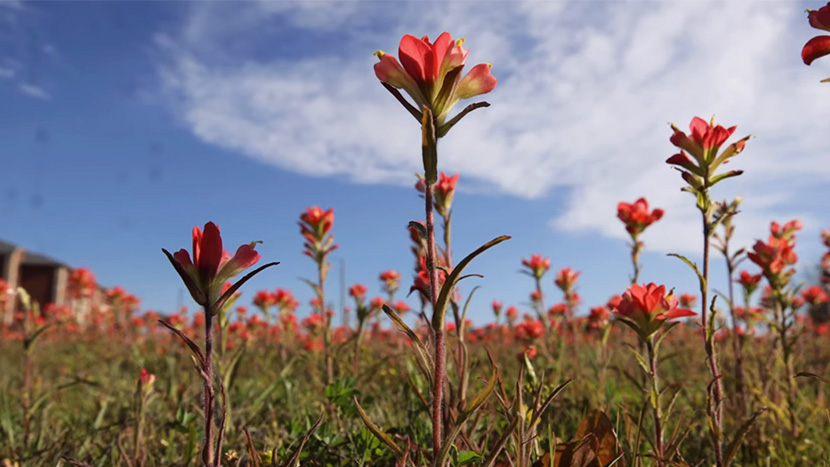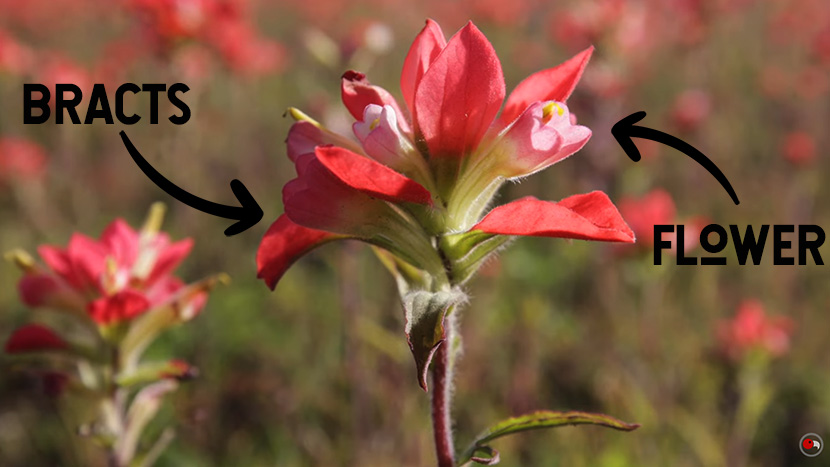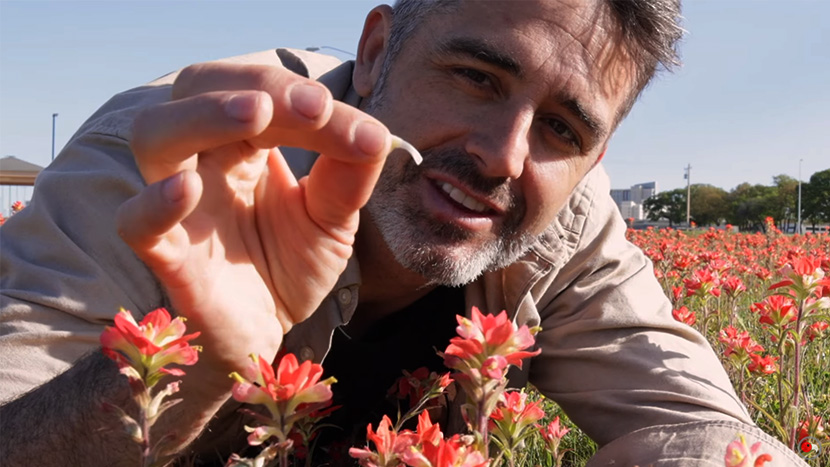Identifying and Foraging Indian Paintbrush

There is a beautiful sprawling grassland in front of you. Grasses and wildflowers sway lazily in the wind under clear skies and the bright mid-day sun. As you scan the landscape, a patch of bright red catches your attention. Like little paint brushes speckled in red sticking straight out of the ground, you have found The Indian Paintbrush!
With mixed conservation status across North America, this beautiful plant with bright red bracts, semi-hidden flowers, and a habit of stealing nutrients from its neighbours, can make for a great little snack, if you know a few things about it first.
What is the Indian Paintbrush ?
The Indian Paintbrush (Castilleja genus) goes by a few different common names, such as Painted Cup, Scarlet Indian Paintbrush or simply Scarlet Paintbrush.
Belonging to the broom-rape family (Orobancaceae), this beautiful plant is annual or biennial – the latter meaning that it takes two years to complete its life cycle. Indian Paintbrush is found mainly in open grasslands, fens, and bordering wetlands but also some shrublands and woodland habitats. They could be also be considered a pyrophyte as their populations seem to do poorly with a lack of semi-frequent fires. In terms of reproduction, they are flowering plants that are mainly pollinated by hummingbirds as well as some insects (mainly bees).
Perhaps the most interesting part of the Indian Paintbrush’s life cycle is that they are hemi parasitic. These flowering plants have evolved the ability to tap into the roots of other living plants and steal their water and nutrients!
They are called hemiparasites (AKA green-root parasites) because they can still photosynthesize – unlike some true parasitic plants such as the ghost pipe. Despite the fact that they are able to make some of their own energy, they aren’t actually able to fully mature and produce flowers until they have successfully parasitized another plant.
That being said, the flowers on The Indian Paintbrush are quite small and inconspicuous, while their iconic red comes from modified leaves called bracts.
Identifying Indian Paintbrush
First off, you can find Indian Paintbrush through Eastern North America, including the Canadian provinces of Saskatchewan, Manitoba, and Ontario, then South over to Maine, and as far South as Eastern Texas over to Florida.
The Indian Paintbrush is a fairly easy plant to identify, the only real trick here is that the bright red part of the plant is not actually the flower, but instead bracts (which are modified leaves) and the flowers are partially hidden away.

Here are some key points to identify Scarlet Paintbrush:
- Grows about 20-60 cm (7-24 inches)
- Long stems are covered in fine hairs
- Colorful bracts that are usually red (this is the part that gets mixed up with the flower)
- The bracts consist of 3-5 tipped lobes (bracts)
- The basal leaves (those around the base of the plant) form a rosette
- The Cauline leaves (those going up the stem) are really variable
- Flowers are pale-yellow to white, sometimes with reddish ends, and are about 2 cm (~3/4 inch)
- Flowers are usually only a bit longer than the calyx and are partially hidden by the bracts
- Subspecies may have yellow bracts
- One plant can have multiple stems and flowers
Is The Indian Paintbrush Endangered?
Globally the Indian Paintbrush is considered secure, but in certain regions populations range from vulnerable to critically imperiled. As just a few examples, the plant is considered critically imperiled in New York, New Jersey, Georgia, Kentucky, and a few more. There’s a lot of data missing though on how populations are doing through much of its range. When in doubt, it is best to assume that it is protected.
Other than development, some of the major threats are from off road vehicles and the encroachment of invasive plant species that outcompete them. Interestingly, even a lack of fire might be causing problems for this plant that has evolved in landscapes that tend to experience frequent fires. (Learn more about beneficial fire here!)
Can You Eat Indian Paintbrush ?
Yes and no. In small amounts and certain areas you can eat Indian Paintbrush flowers but this comes with a word of caution because they can also be toxic. With that being said, there are many toxic plants that can be eaten with the right knowledge, just like eating pokeweed for example.
Eating Indian Paintbrush
Indian paintbrush is essentially a “too much of a good thing” kind of story because it contains selenium, which is important to human health but can also be toxic in high amounts.
First, the good news: Though there are some mixed reviews on the taste of the Indian Paintbrush flowers -from a bit sweet to totally bitter – they do have quite a few benefits such as have Vitamin C, carotenoids, and selenium. Now, the selenium is where things get a bit tricky.
The painted cup plant is really good at taking up selenium in the soil, which can help provide us with this essential mineral, but if the concentration of selenium in the soil is really high, it can lead to toxic levels.
The Problem with Selenium
Selenium is actually essential for human health but in high doses can cause a range of issues. Eating foods with too much selenium, like Brazil nuts, can lead to poisoning. This poisoning can cause symptoms as mild as nausea to extreme cases of abnormalities in the nervous system.
Other Toxins in Indian Paintbrush
In addition to Selenium, remember how we mentioned that Indian Paintbrush steals other compounds from its neighbours? Well, this means that Indian Paintbrush can also suck in toxins from neighbouring plants. So, if there are toxic plants around it, it could easily take in and incorporate these into their tissues.

So what do we recommend ?
This is a great plant to forage for beginners in moderation. Adding some flowers into your salads, teas, or just to snack along the trail can be great, as long as you don’t eat too much. Some things to consider are the concentration of selenium in the soil in your region, as well as what toxic plants are growing in close proximity to this hemiparasite.
Is Indian Paintbrush Medicinal?
The scarlet paintbrush has not only been foraged for a long time for their vitamins and minerals but it is medicinal as well. The Crow People traditionally used the flowers to speed up healing of wounds. Flowers would be ground up, placed on wounds, and held in place by something like willow bark to speed up the healing process.
Wrap Up
The Indian Paintbrush is a beautiful hemiparasitic plant native to South Eastern North America. The flowers can be foraged and eaten or added into teas but in moderation. Some Indian Paintbrush plants may contain higher concentrations of selenium or toxins stolen from neighbouring plants – both of which could make them dangerous in high enough quantities. These flowers were also traditionally used as a tincture to speed up the healing of wounds. Overall, this is a relatively easy plant to identify and one that you can add to your foraging list now that you understand the caveats!
We also featured the Indian paintbrush in this beginners foraging list!

